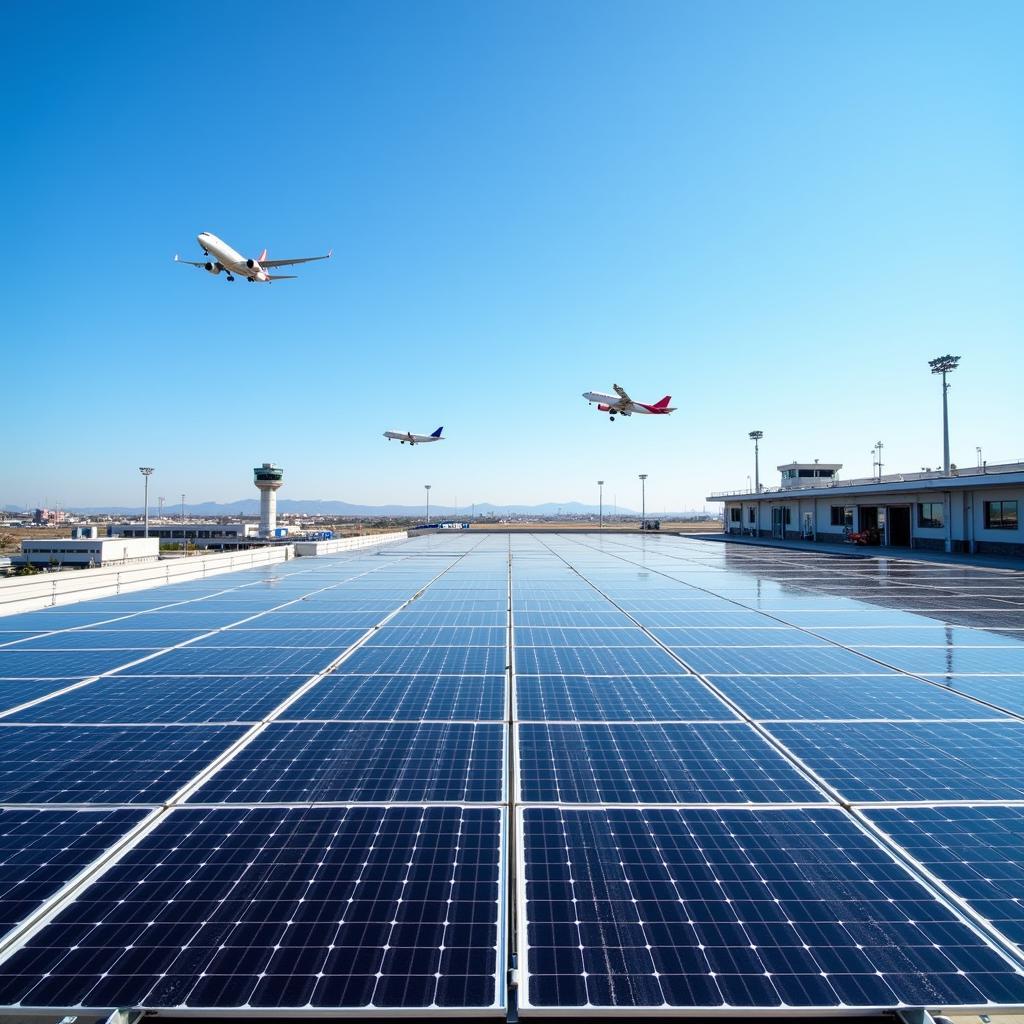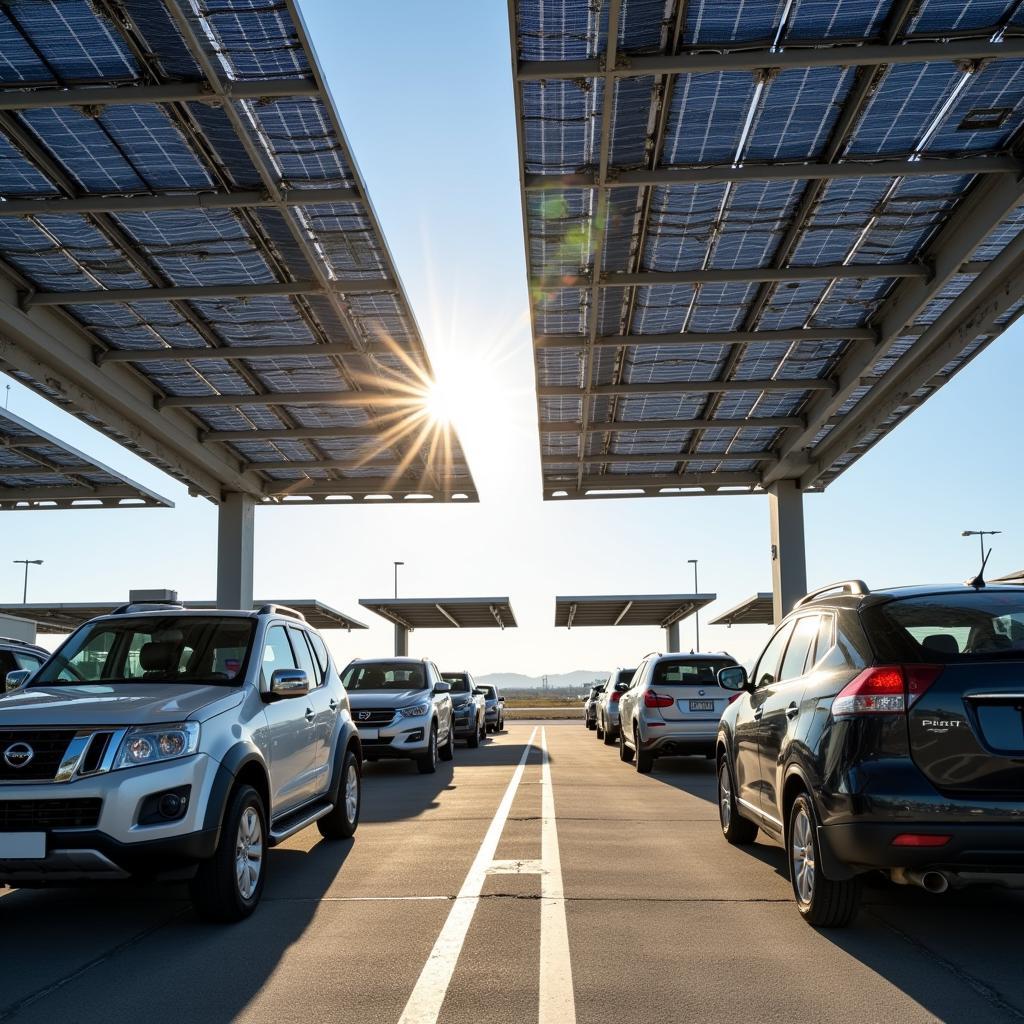Solar Powered Airports are rapidly emerging as a beacon of sustainability within the aviation industry. These innovative hubs are not only reducing their carbon footprint but also demonstrating a commitment to a greener future for air travel. From powering terminals to charging electric ground vehicles, the integration of solar energy is transforming the way airports operate and setting new standards for environmental responsibility.
Similar to iibs bangalore airport campus, many airports are looking to integrate sustainable practices. But what exactly does a solar powered airport entail, and what are the benefits and challenges associated with this groundbreaking technology? Let’s take a closer look.
The Mechanics of a Sun-Powered Airport
A solar powered airport utilizes photovoltaic (PV) systems to convert sunlight directly into electricity. These systems can be installed on terminal rooftops, carports, and even on unused land surrounding the airport. The generated electricity can then be used to power a variety of airport operations, including lighting, heating, cooling, and baggage handling systems. Some airports are even going further, using solar energy to power electric aircraft charging stations and ground transportation fleets. This multifaceted approach reduces reliance on traditional fossil fuels and significantly lowers the airport’s overall environmental impact.
How Do Solar Panels Benefit Airports?
The advantages of integrating solar power into airport infrastructure are numerous and far-reaching. Firstly, the reduction in carbon emissions is substantial, contributing significantly to global efforts to combat climate change. Secondly, solar power offers a long-term cost saving solution. While the initial investment can be significant, the free and abundant nature of sunlight translates into reduced electricity bills over the lifespan of the system. This financial benefit can be reinvested in other airport improvements or used to offset operating costs. Furthermore, solar powered airports enhance their public image, demonstrating a commitment to environmental stewardship and appealing to environmentally conscious travelers.
 Solar Panels on Airport Rooftop: Powering a Sustainable Future
Solar Panels on Airport Rooftop: Powering a Sustainable Future
Overcoming the Challenges of Solar Powered Airports
Despite the numerous benefits, solar powered airports also face certain challenges. The initial cost of installing a large-scale solar power system can be a significant hurdle for some airports. The intermittent nature of sunlight also poses a challenge, requiring energy storage solutions such as batteries to ensure a consistent power supply, especially during nighttime or cloudy weather. Space constraints can also be an issue, particularly for airports located in densely populated areas. However, ongoing advancements in solar technology, including improved efficiency and reduced costs, are continuously addressing these challenges, making solar power an increasingly viable option for airports worldwide.
What are the Different Types of Solar Installations at Airports?
Airports are implementing diverse solar installations tailored to their specific needs and available space. Rooftop installations are common, maximizing the use of existing infrastructure. Ground-mounted systems are utilized when ample land is available, offering larger-scale energy generation. Carport installations not only generate clean energy but also provide shaded parking for passengers. Some innovative airports are even exploring the integration of solar panels into building facades and walkways, further maximizing energy generation potential.
 Airport Solar Carport: Shaded Parking and Clean Energy
Airport Solar Carport: Shaded Parking and Clean Energy
The Future of Solar Powered Airports
The future of solar powered airports is bright. As technology continues to advance and costs decline, we can expect to see a significant increase in the number of airports embracing solar energy. This trend is driven not only by environmental concerns but also by the increasing economic viability of solar power. The integration of smart grid technologies and advanced energy storage solutions will further enhance the reliability and efficiency of solar powered airports. Ultimately, the widespread adoption of solar energy will contribute to a more sustainable and environmentally responsible future for the aviation industry. Like finding an airport bus near me, finding sustainable solutions is becoming increasingly important.
What’s the Environmental Impact of Solar Powered Airports?
The environmental impact of solar powered airports is overwhelmingly positive. By reducing reliance on fossil fuels, these airports significantly decrease their carbon footprint, mitigating the aviation industry’s contribution to climate change. Solar power also reduces air and water pollution associated with traditional power generation methods, leading to cleaner and healthier environments surrounding the airport. This shift towards renewable energy promotes biodiversity and contributes to a more sustainable future for generations to come. Just as knowing the ccu full form in airport is essential for travelers, understanding the environmental benefits of solar powered airports is crucial for a greener future.
 Solar Airport of the Future: Innovation and Sustainability
Solar Airport of the Future: Innovation and Sustainability
Conclusion: Taking Flight Towards a Sustainable Future
Solar powered airports represent a significant step towards a more sustainable aviation industry. By harnessing the power of the sun, these innovative hubs are reducing their environmental impact, lowering operating costs, and setting a new standard for responsible air travel. While challenges remain, the ongoing advancements in solar technology and the increasing commitment to environmental sustainability pave the way for a future where solar powered airports become the norm. Similar to understanding the layout with a hamad international airport map, knowing the benefits of sustainable airports is crucial for future travel.
FAQ
-
What are the main benefits of solar powered airports?
Reduced carbon emissions, lower operating costs, and enhanced public image. -
What are the challenges of implementing solar power at airports?
Initial costs, intermittent sunlight, and space constraints. -
How do solar panels generate electricity at airports?
Photovoltaic (PV) systems convert sunlight directly into electricity. -
What are the different types of solar installations at airports?
Rooftop, ground-mounted, and carport installations. -
What is the future of solar powered airports?
Increased adoption driven by technological advancements and economic viability. -
How does solar power reduce an airport’s environmental impact?
By reducing reliance on fossil fuels and decreasing carbon emissions. -
What are some examples of airports using solar power?
Several airports worldwide are already implementing solar power solutions. Knowing opportunities like a 10th pass job in lucknow airport and the sustainable initiatives of airports can be beneficial.
For further assistance please contact Phone Number: +13089626264, Email: [email protected] Or visit: 404 Bothwell St, Oxford, NE 68967, USA. We have a 24/7 customer service team.
